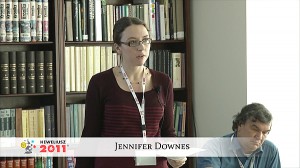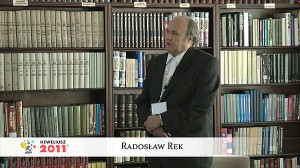Konferencja Hevelius 2011 – Sesja 4 – Kathrin Müller
 Temat: Kreśląc linie: sztuka i nauka w Selenografii Jana Heweliusza (1647).
Temat: Kreśląc linie: sztuka i nauka w Selenografii Jana Heweliusza (1647).
W swej pierwszej książce Selenographia, sive, Lunae descriptio, wydanej w 1647 roku i uważanej za pierwszy kompletny atlas Księżyca, Jan Heweliusz przywiązuje wielką wagę do swoich umiejętności budowniczego instrumentów, rysownika i rytownika, gdyż umożliwiły mu one kontrolowanie odkryć i gwarantowały jak najdokładniejsze odwzorowanie obrazów widzianych za pomocą teleskopu na kartach dzieła. Natomiast brak przedstawienia w Sidereus nuncius (1610) Galileusza Księżyca w pełni kładzie na karb słabej jakości teleskopów Włocha, jego braku cierpliwości i, przede wszystkim, braku umiejętności rysowniczych. Co więcej, Heweliusz wyjaśnia czytelnikowi, aby nie traktował rycin w książce jako bezpośrednich, nieprzetworzonych przedstawień. Stara się raczej dowieść, że obserwacja teleskopowa posługuje się różnymi rodzajami obrazów zgodnie z potrzebami i możliwościami książki drukowanej. W wystąpieniu tym zostanie prześledzone staranne wykorzystanie przez Heweliusza linii w procesie tworzenia rycin i przeanalizowana jego świadomość faktu, że można ją wykorzystywać na różne sposoby – poprzez ukazanie jego pragnień i umiejętności rysownika oraz rytownika na tle amatorskiego kształcenia w sztukach pięknych w XVII wieku.
materiał w języku angielskim
Kathrin Müller (Frankfurt University):
Drawing Lines: Art and Science in Johannes Hevelius’s Selenographia (1647)
In his first book, Selenographia: sive, Lunae descriptio, published in 1647 and classified as the first full atlas of the Moon, Johannes Hevelius sets great store by his abilities as an instrument-maker, draughtsman and engraver since they enable him to retain control over his findings and guarantee a particularly accurate agreement between the images as seen through the telescope and their representations on the page. By contrast, he attributes the want of a proper delineation of the full Moon in Galileo’s Sidereus nuncius (1610) to the inadequacy of Galileo’s telescopes, his lack of patience and, above all, his incompetence to draw. Moreover, Hevelius prompts his readers not to misapprehend the visual material on the pages of his book as direct, unaltered representations. Rather, he demonstrates that telescopic observation utilized various kinds of images according to requirements and virtues of the printed book.
This paper traces Hevelius’s careful employment of the line and his awareness of its different representational qualities by placing his ambitions and skills as a draughtsman and engraver within the context of the education of amateurs in the pictorial arts in the seventeenth century.


